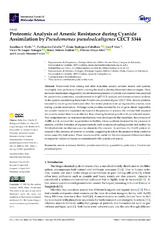Mostrar el registro sencillo del ítem
Proteomic Analysis of Arsenic Resistance during Cyanide Assimilation by Pseudomonas pseudoalcaligenes CECT 5344
| dc.contributor.author | Biełło, Karolina A. | |
| dc.contributor.author | Cabello, Purificación | |
| dc.contributor.author | Rodríguez Caballero, Gema | |
| dc.contributor.author | Sáez, Lara P. | |
| dc.contributor.author | Luque-Almagro, Víctor Manuel | |
| dc.contributor.author | Roldán, María Dolores | |
| dc.contributor.author | Olaya-Abril, Alfonso | |
| dc.contributor.author | Moreno-Vivián, Conrado | |
| dc.date.accessioned | 2023-04-14T07:57:35Z | |
| dc.date.available | 2023-04-14T07:57:35Z | |
| dc.date.issued | 2023 | |
| dc.identifier.uri | http://hdl.handle.net/10396/25114 | |
| dc.description.abstract | Wastewater from mining and other industries usually contains arsenic and cyanide, two highly toxic pollutants, thereby creating the need to develop bioremediation strategies. Here, molecular mechanisms triggered by the simultaneous presence of cyanide and arsenite were analyzed by quantitative proteomics, complemented with qRT-PCR analysis and determination of analytes in the cyanide-assimilating bacterium Pseudomonas pseudoalcaligenes CECT 5344. Several proteins encoded by two ars gene clusters and other Ars-related proteins were up-regulated by arsenite, even during cyanide assimilation. Although some proteins encoded by the cio gene cluster responsible for cyanide-insensitive respiration decreased in the presence of arsenite, the nitrilase NitC required for cyanide assimilation was unaffected, thus allowing bacterial growth with cyanide and arsenic. Two complementary As-resistance mechanisms were developed in this bacterium, the extrusion of As(III) and its extracellular sequestration in biofilm, whose synthesis increased in the presence of arsenite, and the formation of organoarsenicals such as arseno-phosphoglycerate and methyl-As. Tetrahydrofolate metabolism was also stimulated by arsenite. In addition, the ArsH2 protein increased in the presence of arsenite or cyanide, suggesting its role in the protection from oxidative stress caused by both toxics. These results could be useful for the development of bioremediation strategies for industrial wastes co-contaminated with cyanide and arsenic. | es_ES |
| dc.format.mimetype | application/pdf | es_ES |
| dc.language.iso | eng | es_ES |
| dc.publisher | MDPI | es_ES |
| dc.rights | https://creativecommons.org/licenses/by/4.0/ | es_ES |
| dc.source | International Journal of Molecular Science, 24(8), 7232 (2023) | es_ES |
| dc.subject | Arsenic resistance | es_ES |
| dc.subject | Biofilm | es_ES |
| dc.subject | Cyanide assimilation | es_ES |
| dc.subject | Quantitative proteomic | es_ES |
| dc.subject | Pseudomonas pseudoalcaligenes | es_ES |
| dc.title | Proteomic Analysis of Arsenic Resistance during Cyanide Assimilation by Pseudomonas pseudoalcaligenes CECT 5344 | es_ES |
| dc.type | info:eu-repo/semantics/article | es_ES |
| dc.relation.publisherversion | https://doi.org/10.3390/ijms24087232 | es_ES |
| dc.relation.projectID | Junta de Andalucía. P18-RT-304 | es_ES |
| dc.relation.projectID | Gobierno de España. TI2018-099573-B-100 | es_ES |
| dc.rights.accessRights | info:eu-repo/semantics/openAccess | es_ES |

